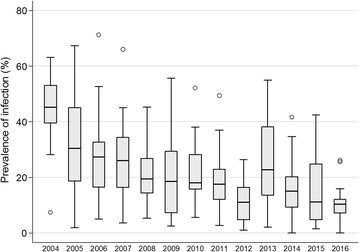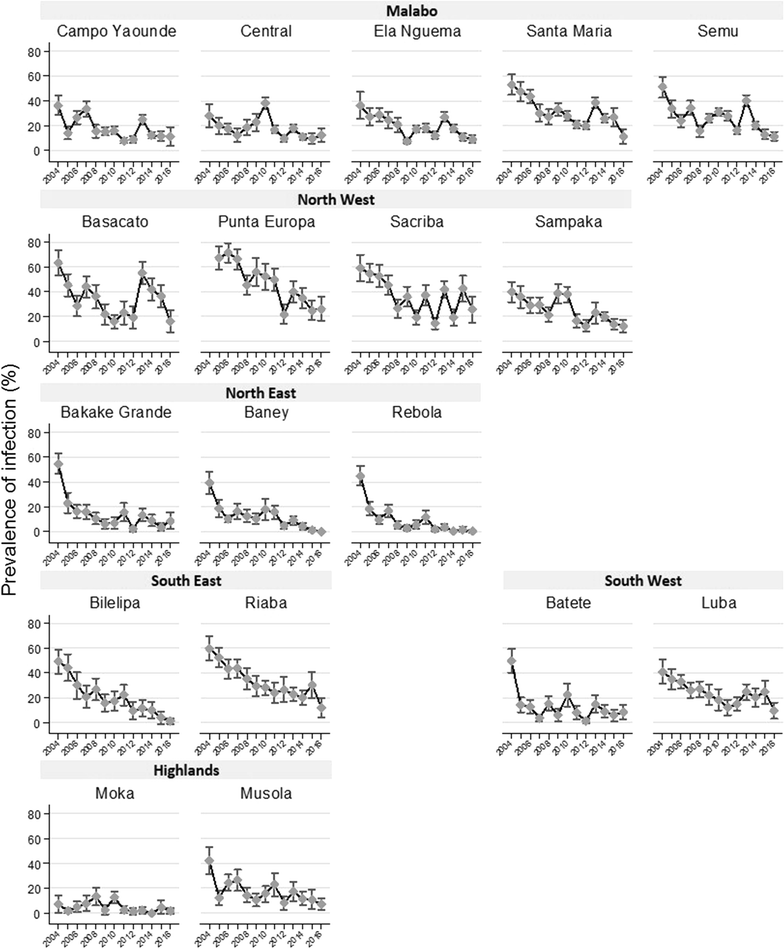Trends in parasite prevalence following 13 years of malaria interventions on Bioko island, Equatorial Guinea: 2004-2016
- PMID: 29402288
- PMCID: PMC5799938
- DOI: 10.1186/s12936-018-2213-9
Trends in parasite prevalence following 13 years of malaria interventions on Bioko island, Equatorial Guinea: 2004-2016
Abstract
Background: Whilst there have been substantial reductions in malaria transmission over the past decade, in many countries in West and Central Africa the malaria burden remains high. Monitoring and evaluation of malaria transmission trends and intervention strategies are key elements for malaria control programmes. This study uses a time series of annual malaria indicator surveys to track the progress of malaria control in Bioko Island, Equatorial Guinea, over a 13 year period of intensive interventions. Malaria infection and haemoglobin were measured annually in children (1 to 14 years) in cross-sectional household surveys from 2004 to 2016 in 18 sentinel sites across the island. Trends in transmission patterns were assessed and the impact of the vector control interventions (net use and spray coverage) was evaluated.
Results: Between 2004 and 2016 approximately 106,500 individual tests for parasitaemia were conducted using rapid diagnostic tests. Although spray coverage remained relatively high (> 70%) over the time period, reported net usage was generally below 40%. Parasite prevalence reduced from 43.3 to 10.5% between 2004 and 2016. The prevalence of moderate to severe anaemia in children aged 1-5 years reduced from 14.9 to 1.6%. Impact in individual sites ranged from 57 to 100% reductions in parasite prevalence between 2004 and 2016. Sleeping under a net and living in a house that had been sprayed in the past 12 months were independently protective against infection (OR = 0.69 [95%CI 0.61-0.80] and OR = 0.87 [95% CI 0.78-0.97], respectively), whilst recent travel to the mainland increased the odds of infection nearly fourfold (OR = 3.94 [95%CI 2.79-5.56]).
Conclusion: Island-wide interventions have resulted in a substantial reduction in malaria transmission on Bioko Island. This unique time series of 13 consecutive annual malaria indicator surveys clearly demonstrates the long-term effectiveness of the sustained use of two vector control interventions, indoor residual spraying and LLINs, and the value of comprehensive and sustained surveillance. Despite considerable success in reducing the burden on the island, malaria is still endemic, with populations in some areas remaining at high risk of infection.
Keywords: Epidemiology; Intervention; Longitudinal; Malaria; Monitoring and evaluation; Vector control.
Figures





References
-
- Farnert A, Yman V, Homann MV, Wandell G, Mhoja L, Johansson M, et al. Epidemiology of malaria in a village in the Rufiji River Delta, Tanzania: declining transmission over 25 years revealed by different parasitological metrics. Malar J. 2014;13:459. doi: 10.1186/1475-2875-13-459. - DOI - PMC - PubMed
MeSH terms
Grants and funding
LinkOut - more resources
Full Text Sources
Other Literature Sources
Medical
Miscellaneous

